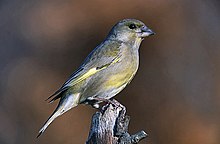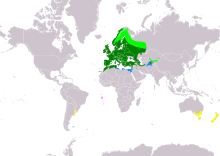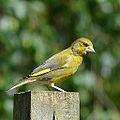
The true finches are small to medium-sized passerine birds in the family Fringillidae. Finches generally have stout conical bills adapted for eating seeds and nuts and often have colourful plumage. They occupy a great range of habitats where they are usually resident and do not migrate. They have a worldwide native distribution except for Australia and the polar regions. The family Fringillidae contains more than two hundred species divided into fifty genera. It includes the canaries, siskins, redpolls, serins, grosbeaks and euphonias, as well as the morphologically divergent Hawaiian honeycreepers.
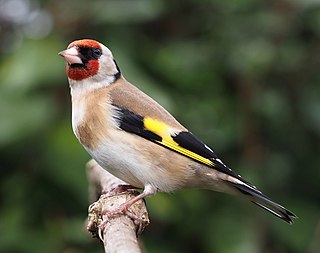
The European goldfinch or simply the goldfinch is a small passerine bird in the finch family that is native to Europe, North Africa and western and central Asia. It has been introduced to other areas, including Australia, New Zealand and Uruguay.

The Eurasian chaffinch, common chaffinch, or simply the chaffinch is a common and widespread small passerine bird in the finch family. The male is brightly coloured with a blue-grey cap and rust-red underparts. The female is more subdued in colouring, but both sexes have two contrasting white wing bars and white sides to the tail. The male bird has a strong voice and sings from exposed perches to attract a mate.

The genus Carduelis is a group of birds in the finch family Fringillidae.

The brambling is a small passerine bird in the finch family Fringillidae. It has also been called the cock o' the north and the mountain finch. It is widespread and migratory, often seen in very large flocks.

The common redpoll or mealy redpoll is a species of bird in the finch family. It breeds somewhat further south than the Arctic redpoll, also in habitats with thickets or shrubs.

The common linnet is a small passerine bird of the finch family, Fringillidae. It derives its common name and the scientific name, Linaria, from its fondness for hemp seeds and flax seeds—flax being the English name of the plant from which linen is made.

The European serin, or simply the serin, is the smallest species of the family of finches (Fringillidae) and is closely related to the Atlantic canary. Its diet consists mainly of a combination of buds and seeds.
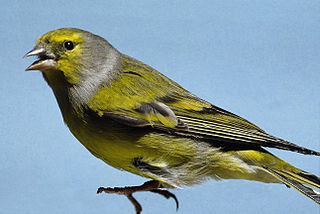
The citril finch, also known as the Alpine citril finch, is a small songbird, a member of the true finch family, Fringillidae.

The desert finch, sometimes called Lichtenstein's desert finch, is a large brown true finch found in southern Eurasia. Its taxonomy is confused, and it has formerly been placed in Fringilla, Bucanetes, Carduelis and Rhodopechys.

The grey-capped greenfinch or Oriental greenfinch is a small passerine bird in the finch family Fringillidae that breeds in broadleaf and conifer woodlands of the East Palearctic.

The British finches are made up of several species of finch which were formerly very popular as cage birds in Great Britain. They are not currently commonplace, but are still kept by a few dedicated fanciers.

The genus Rhynchostruthus is a small group of finches in the family Fringillinae. Commonly known as golden-winged grosbeaks, they are attractive, chunky, medium-sized, robust-billed songbirds restricted to the southern Arabian and northern Somalian regions.
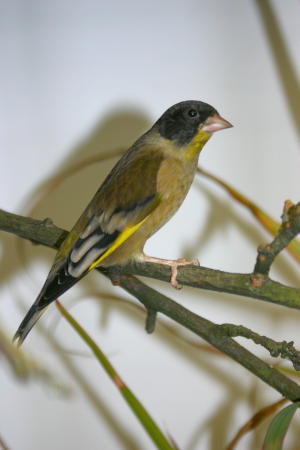
The black-headed greenfinch is a small passerine bird in the family Fringillidae. It is found in the Chinese province of Yunnan, northern Laos, eastern Myanmar and adjacent areas of Vietnam, Thailand and Northeast India. Its natural habitats are subtropical or tropical dry forest and subtropical or tropical dry shrubland.
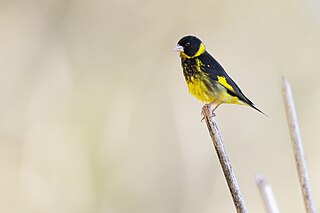
The Vietnamese greenfinch is a small passerine bird in the family Fringillidae. It is found only in Đà Lạt Plateau of southern Vietnam. Its natural habitat is open montane pine forest and scrubland. It is threatened by habitat loss.
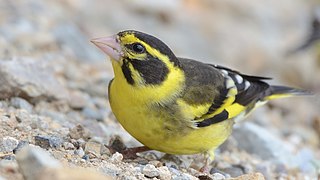
The yellow-breasted greenfinch is a small passerine bird in the family Fringillidae that is native to the northern regions of the Indian subcontinent.

The greenfinches are small passerine birds in the genus Chloris in the subfamily Carduelinae within the Fringillidae. The species have a Eurasian distribution except for the European greenfinch, which also occurs in North Africa.

The La Palma chaffinch, also known as the Palman chaffinch or, locally in Spanish as the pinzón palmero or pinzón hembra, is a small passerine bird in the finch family Fringillidae. It is a subspecies of the common chaffinch that is endemic to La Palma in the Canary Islands, a Spanish archipelago that forms part of Macaronesia in the North Atlantic Ocean.

Trichomonas gallinae is a cosmopolitan parasite of birds including finches, pigeons, doves, turkeys, chickens, parrots, raptors. The condition in birds of prey is called frounce. It is believed to be an ancient pathogen causing frounce-like symptoms in theropod dinosaurs. The same condition in pigeons is commonly called canker.

The slender-billed greenfinch("Carduelis" aurelioi) is an extinct songbird in the finch family Fringillidae. It was endemic to the island Tenerife in the Canary Islands, and became extinct after human settlement of the islands.

